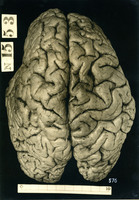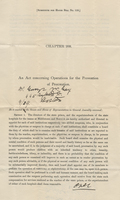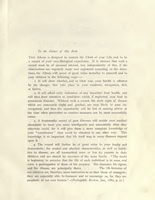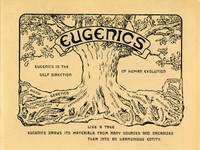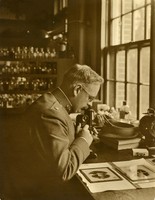Browse Items (35 total)
- Tags: Exhibit: Galton's Children
Sort by:
A group of deaf-mute families from Maine
As part of his research on deafness, Alexander Graham Bell made statistical analyses of the deaf-mutes and determined that deafness was hereditary and that the number of intermarriages between deaf-mutes was high and growing. He concluded that…
Composite Portraits
An arrangement of composite portraits by Henry Pickering Bowditch (1840-1911) in the publication from the second International Exhibition of Eugenics in 1921. While the composite photographs on display here as well as others in the collections of the…
Twelve Boston physicians and their composite portrait
Dr. H. P. Bowditch took photographs of himself and eleven colleagues—all members of a physician’s dining club, the Kappa Pi Eta—in 1887 and again in 1892 and then devised a composite portrait of all twelve to isolate the common…
A group of Saxon soldiers and their composite
Bowditch reproduced and described this composite image of Saxon soldiers, as well as a composite image of Wend soldiers, in his article, “Are composite photographs typical pictures?” printed in McClure’s magazine in September 1894.…
A group of Wend soldiers and their composite
Bowditch reproduced and described this composite image of Wend soldiers, as well as a composite image of Saxon soldiers, in his article, “Are composite photographs typical pictures?” printed in McClure’s magazine in September 1894.…
Brain of an alcoholic vagrant
Dr. Myrtelle May Canavan, pathologist with the Massachusetts Department of Mental Diseases and a member of the staff of the Boston Psychopathic Hospital, displayed enlarged photographs of fifty brains of criminals and feeble-minded individuals at the…
An act concerning operations for the prevention of procreation
A bill for the sterilization of inmates of prisons and insane hospitals “by whom procreation would be inadvisable” was introduced into the Connecticut legislature by Representative Wilbur F. Tomlinson in February, 1909. The bill passed…
Heredity in relation to eugenics
Harvard graduate, Charles Benedict Davenport, was one of the leaders of the American eugenics movement. In 1904, he became the director of the Carnegie Institution’s Station for Experimental Evolution at Cold Spring Harbor, on Long Island, and…
Fifth generation of the Juke Family
One of the first and most influential of the eugenic studies of a pseudonymous family, Richard L. Dugdale’s The Jukes traces the origins of imprisoned members of the same family back to the colonial period to examine inherited and environmental…
Eugenical News
One of the early periodical publications devoted to eugenics, the Eugenical news started in 1916 and was, at various times, the official organ of the Eugenics Research Association and then the American Eugenics Society. Appearing monthly, the…
The Eugenics Review
The official organ for the Eugenics Society in England, The eugenics review first appeared in 1909 and was published continuously until this, its final volume under that title. In 1969, the publication was reformulated as the Journal of biosocial…
Hereditary genius : an inquiry into its laws and consequences
Francis Galton, influenced by the work of Charles Darwin, came to believe that, following research into the biographies and genealogies of 400 famous individuals—judges, statesmen, poets, painters, scientists and athletes—genius was…
Men of Science
Francis Galton, influenced by the work of Charles Darwin, came to believe that, following research into the biographies and genealogies of 400 famous individuals—judges, statesmen, poets, painters, scientists and athletes—genius was…
Inquiries into Human Faculty and its Development
In the notes to the introduction of this work, which assembles and revises his writings since the publication of Hereditary genius, Galton coins the neologism which gave its name to a movement: “That is, with questions bearing on what is termed…
Memories of My Life
At the conclusion of this autobiographical account, Galton considers the goal of his work on eugenics and its contrast to Darwinian natural selection: “Man is gifted with pity and other kindly feelings; he has also the power of preventing many…
Sir Francis Galton
Photograph of Sir Francis Galton from his book Memories of my life. Found on the plate facing page 244.
Life History Album
Intended to chart the medical history of an individual from birth until the age of 75, the Life history album, edited by Francis Galton, allows for notes on the genealogy, life, development, marriage, children, height and weight observations,…
Letter to Henry Pickering Bowditch from Sir Francis Galton
Galton admires the composites of Saxon and Wend soldiers done by Bowditch. He says: “The composites are indeed beautiful and quite different in ‘type’ from both American and English. The Saxon & Wends being more alike to one…
What can be done to better the race?
This letter by Gay summarizes the state of eugenics and alludes to the states which have enacted sterilization laws but concedes that an educational program is the most practical means to promote eugenic policy. The article was reprinted as…
Draft of letter to Ernest V. Scribner from George Washington Gay
Former lecturer in surgery at Harvard and senior surgeon at Boston City Hospital, George W. Gay was approached by the Massachusetts Commission for expert advice on vasectomy and enforced sterilization: “The most feasible method of controlling…
The Kallikak family : a study in the heredity of feeble-mindedness
Henry Herbert Goddard’s study, The Kallikak family, tracks 480 descendants of Martin Kallikak, known as the “Old Horror,” the illegitimate son of a feeble-minded girl. Among the descendants were alcoholics, prostitutes, epileptics,…
Certificate of appreciation from the Second International Congress of Eugenics
For her contribution to the Second International Congress of Eugenics exhibit, Dr. Canavan was presented with this certificate of appreciation.
Eugenics, genetics and the family : scientific papers of the Second International Congress of Eugenics
There were three international meetings of eugenics researchers during the period of the movement’s greatest influence and activity. This volume reprints the scientific papers from the Second Congress, held at the American Museum of Natural…
The Second International Exhibition of Eugenics
Harry Hamilton Laughlin was chairman of the Committee on Exhibits associated with the Second International Congress and organized this display at the American Museum of Natural History in the fall of 1921. A gift of $2,500 from Mrs. E. H. Harriman…
Eugenical sterilization in the United States
Harry H. Laughlin was director of Eugenics Record Office for thirty years and assisted Charles B. Davenport in first publishing the Eugenics Research Association’s Eugenical news to promote the activities of the Office. In 1922, he compiled and…
Heredity and human progress
In this radical work, Washington physician, William Duncan McKim, proposed moving beyond sterilization of the “very weak and the very vicious” to liquidation by the state through the use of carbonic acid gas. In his chapter “A…
Heredity : its relation to human development
In 1880, Bostonian Loring Moody, familiar with Galton’s work, issued a circular to form an Institute of Heredity, part school, part library, to promote lectures and interest in addressing social ills through eugenic principles. The circular…
Forgotten Children
This fundraising brochure from the National Mental Health Foundation makes a plea for compassion, better care, and education of the feeble-minded and sharply criticizes the family studies of the eugenics movement: “More than a generation ago…
Reactivation of the Dight Institute, 1947-1949: Counseling in human genetics
Physician Charles F. Dight (1856-1938) was the first president of the Minnesota Eugenics Society and promoted the state’s adoption of a law for the sterilization of the feeble-minded and insane in 1925. He bequeathed his fortune to the…
Concerning the study of eugenics in Massachusetts
Harvard’s Bullard Professor of Neuropathology, E. E. Southard, presented this report on the desirability of eugenic research in Massachusetts, to the Board of Directors of the Eugenics Record Office, probably at its first meeting on December…
Henry Pickering Bowditch
A picture of Henry Pickering Bowditch. Bowditch was appointed Assistant Professor of Physiology in 1871, Professor of Physiology, 1876, and became the first George Higginson Professor of Physiology in 1902, Emeritus, 1906. Bowditch served as Dean of…
Charles Fremont Dight
Picture of Charles Fremont Dight from Bulletin no. 1 of the Dight Institute






